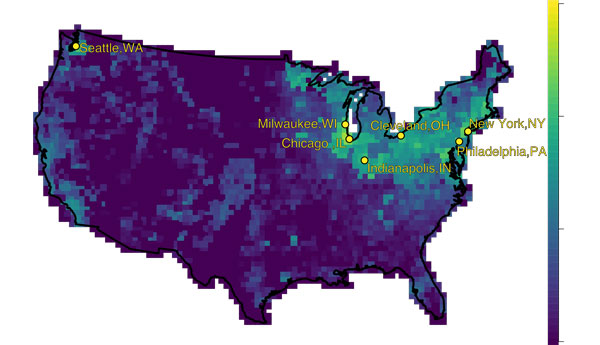
About 82% of the U.S. population lives in urban areas, and that number is growing. People are drawn from near and far to cities for jobs, restaurants and entertainment. They also enjoy green spaces within a bustling cityscape. Parks, forests and tree-lined streets provide respite and recreation, places to pause and ponder. Trees in urban areas also benefit residents by lowering cooling costs and improving mental health outcomes.
Several U.S. cities, shown in yellow on the map above, may be hotspots for tree mortality from the invasive emerald ash borer beetle. The map also shows other locations in the insect’s path over the next 30 years. Dark blue areas have lower risk, while lighter blue and green areas may experience greater risks and costs.
“Frequent travel to and from cities means that trees in urban areas have high rates of exposure to invasive species like the emerald ash borer,” said Frank Koch, a USDA Forest Service research ecologist and co-author of a new study about the impacts of invasive insects on urban trees.
The emerald ash borer is a wood-boring beetle native to Asia. First discovered in the U.S. in 2002, the beetle was brought here accidentally – likely on a wooden pallet filled with imported goods like toasters or electronics. The emerald ash borer is now found in 35 states and Canada and has killed hundreds of millions of ash trees.
The insect feeds on wood tissue just under the bark. It cuts off a tree’s water and nutrient supply, making it much deadlier than pests that feed on leaves.
In some towns and cities, ash trees were planted in groups and in great numbers. (Think of all the “Ash Streets” in communities throughout the Northeast.) Now these locations have become hotspots for the emerald ash borer. Chicago, Milwaukee, New York City and innumerable smaller municipalities are having to remove and replace dead ash trees.
“It’s a cautionary tale against planting a single type of tree throughout entire cities,” said Emma Hudgins, a researcher with McGill University who led the study.
Over the next 30 years, the study estimates that 1.4 million street trees in the U.S. will be killed by invasive insects. Researchers estimate that the replacement cost could exceed $900 million. About 90% of the impacts will be due to the emerald ash borer. It’s expected to kill nearly all ash trees – not just those growing along streets, but also those in parks and yards – in more than 6,000 U.S. municipalities.
Forest Service scientists are looking to solutions. Research confirms the value of early intervention strategies that prevent invasive species from becoming established, as well as the importance of detecting and responding quickly to new species incursions. Early detection and monitoring programs will be most effective. Land managers can also slow the spread of invasive insects by treating infected trees with insecticides as soon as possible. Scientists are also studying how some wasps can be used to reduce emerald ash borer populations.
Ash trees across the country are being decimated by the emerald ash borer, leading to costly removals in cities and neighborhoods like this one in Maryland. (Courtesy photo by The Chesapeake Bay Program)
One step that everyone can take to prevent the further spread of the emerald ash borer and other pests: Don’t move firewood. Instead, use local sources and burn it where you buy it.
In the future, homeowners and urban planners will probably want to have a greater variety of tree species in their yards, parks and green spaces. Tree diversity provides resilience, as most pests target a single type of tree. A diverse urban forest also provides food and habitat for native pollinators.
If you think you have emerald ash borers on your property, or have seen them somewhere, contact a local expert for help with identification and treatment options.
A humble homesteader based in an undisclosed location, Lars Drecker splits his time between tending his little slice of self-sustaining heaven, and bothering his neighbors to do his work for him. This is mainly the fault of a debilitating predilection for fishing, hunting, camping and all other things outdoors. When not engaged in any of the above activities, you can normally find him broken down on the side of the road, in some piece of junk he just “fixed-up.”
